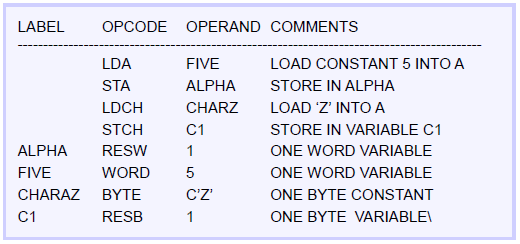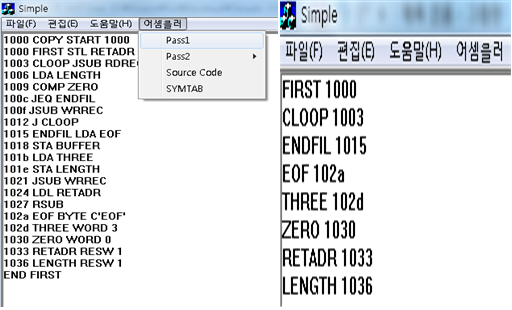2-Pass SIC Assembler
SIC(Simplified Instructional Computer) : 실제의 기계에서 흔히 발견되는 특이성을 포함하지 않고, 가장 보편적인 하드웨어 특징과 개념을 보여줄 수 있도록 설계
SIC 어셈블리
어셈블리
- 사람들이 이진 숫자로만 명령을 나타내는 것이 어려운 일이므로 이를 보다 쉽게 하기 위해 이진 숫자 대신 상징적인 단어 또는 심볼을 써서 명령을 표현
- 각 명령의 대상이 되는 피연산자, 예를 들면 덧셈명령인 경우 더해져야 할 숫자들이 저장된 주기억장치의 주소를 숫자 대신 심볼로 나타낼 수 있게 함
어셈블리 언어는 보통 Label, Opcode, Operand, Comment 형태로 구성됨
- Label : 고급언어에서 문번호에 해당하는 부분
- Opcode : 명령어 부분
- 지정어로 반드시 어셈블러가 인식할 수 있는 word들로 구성되어야 함
- Operand : 명령어를 수행할 때 필요한 데이터 부분
- 변수나 상수에 해당하는 부분으로 프로그래머 임의로 변수명을 줄 수 있음
- 어셈블리에 따라서 여러 개로 구성되는 것이 보통임
- Comment : 주석 부분
- Documentation 목적으로 사용하며 기계어하고는 아무런 관계가 없다

Pass 1
begin
read first input line
if OPCODE = 'START' then
begin
save #[OPERAND] as starting address
initialize LOCCTR to starting address
write line to intermediate file
read next input line
end
else
initialize LOCCTR to 0
while OPCODE < > 'END' do
begin
if this is not a comment line then
begin
if there is a symbol in the LABEL field then
begin
search SYMTAB for LABEL
if found then
set error flag (duplicate symbol)
else
insert (LABEL LOCCTR) into SYMTAB
end
search OPTAB for OPCODE
if found then
add 3 (instruotion length) to LOCCTR
else if OPCODE = 'WORD' then
add 3 to LOCCTR
else if OPCODE = 'RESW' then
add 3 * #[OPERAND] to LOCCTR
else if OPCODE = 'RESB' then
add #[OPERAND] to LOCCTR
else if OPCODE = 'BYTE' then
begin
find length of constant in bytes
add length to LOCCTR
end
else
set error flag (invalid operation code)
end {if not a comment}
write line to intermediate file
read next input line
end {while}
write last line to intermediate file
save (LOCCTR - starting address) as program length
end {Pass 1}Pass 2
begin
read first input line (from intermediate file)
if OPCODE = 'START' then
begin
write listing line
read next input line
end
write Header record to object program
initialize first Text record
while OPCODE () 'END' do
begin
if this is not a comment line then
begin
search OPTAB for OPCODE
if found then
begin
if there is a symbol in OPERAND field then
begin
search SYMTAB for OPERAND
if found then
store symbol value as operand address
else
begin
store 0 as operand address
set error flag (undefined symbol)
end
end {if symbol}
else
store 0 as operand address
assemble the object code instruction
end {if found}
else if OPCODE = 'BYTE' or 'WORD' then
convert constant to object code
if object code will not fit into the current Text record then
begin
write Text record to object program
initialize new Text record
end
add object code to Text record
end {if not comment}
write listing line
read next input line
end {while}
write last Text record to object program
write End record to object program
write last listing line
end {Pass 2}목적 프로그램의 형식
-
헤더 레코드(Header record)
열 1 H
열 2-7 프로그램 이름
열 8-13 목적 프로그램의 시작주소(16진수)
열 14-19 바이트로 표시된 목적 프로그램의 길이(16진수) -
텍스트 레코드(Text record)
열 1 T
열 2-7 레코드에 포함될 목적 코드 시작주소(16진수)
열 8-9 바이트로 나타낸 이 레코드의 길이(16진수)
열 10-69 16진수로 나타낸 목적 코드(목적 코드 1바이트 당 2개의 열) -
엔드 레코드(End record)
열 1 E
열 2-7 목적 프로그램 중 첫번째로 실행될 명령어의 주소(16진수)
패스 1 (기호 정의)
- 프로그램 내의 모든 문에 주소 배정
- 모든 레이블에 배정된 주소 저장
- 어셈블러 지시자의 부분적 처리
- BYTE, RESW 등에 의하여 정의되는 데이터 영역의 길이 결정과 같은 주소배정에 영향을 주는 처리 포함
패스 2 (명령어 번역, 목적 프로그램의 생성)
- 명령어 어셈블(연산자 코드 번역하고 주소 조사)
- BYTE, WORD 등으로 정의되는 데이터 값 생성
- 패스 1 동안 이루어지지 않은 지시자의 처리
- 목적 프로그램과 어셈블러 리스트 출력
테이블과 변수
- OPTAB(Operation Code Table : 연산코드 테이블)
- 연산 명령어 찾아 기계 코드로 번역하는 데 사용
- SYMTAB(Symbol Table : 기호테이블)
- 레이블들에 배정된 주소를 저장하는 데 사용
- LOCCTR(Location Counter : 위치계수기)
- 주소배정 처리하는 데 사용
- START 문에서 나타낸 시작주소로 초기화
- 각 원시 문장이 처리될 때 마다 어셈블 된 명령어나 생성된 데이터 영역의 길이가 LOCCTR에 더해지고, 원시 프로그램에서 레이블을 만날 때마다 LOCCTR의 현재 값을 레이블의 주소로 배정함
2학년 때 시스템 프로그래밍 과목을 수강했었는데 이 때 MFC로 만든 2-pass SIC 어셈블러이다.


